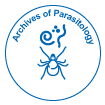Does Trypanosoma brucei brucei have the Ability to Invade Human Microglial Cells?
Received Date: May 02, 2017 / Accepted Date: Jun 08, 2017 / Published Date: Jun 15, 2017
Abstract
African trypanosomes are flagellated extracellular parasites, causal agents of African trypanosomiasis. Trypanosoma brucei is the most frequent species for the majority of African trypanosomiasis. Two sub-species are pathogenic for humans: Trypanosoma brucei gambiense and Trypanosoma brucei rhodesiense while Trypanosoma brucei brucei is not.
Objective: The aim of this work was to study the infectivity of Trypanosoma brucei brucei, on human microglial cells (CMH-5).
Methods: Trypanosomes (Trypanosoma brucei brucei Antat 1.9) labeled with a fluorescent dye were co-cultured with CMH-5 cells for 3 h. The nucleus and cytoskeletal microtubules of the cells were then labeled with two fluorescent dyes and the stained cell layer was examined by confocal microscopy.
Results: Trypanosomes were observed within CMH-5 cells.
Conclusion: Trypanosoma brucei brucei, a non-human parasite and described as an extracellular parasite, appears to have the ability to enter in human microglial cells in vitro. This raises a number of issues concerning the behaviour of this parasite in the human CNS and the immune response initiated by microglial cells which corresponds to endogenous defenses of the human brain.
Keywords: African trypanosomiasis; Trypanosoma brucei brucei; Human microglial cell; Intra-cellular parasite; Confocal microscopy
Citation: Bonnet J, Boudot C, Courtioux B (2017) Does Trypanosoma brucei brucei have the Ability to Invade Human Microglial Cells?. Arch Parasitol 1: 108.
Copyright: © 2017 Bonnet J, et al. This is an open-access article distributed under the terms of the Creative Commons Attribution License, which permits unrestricted use, distribution, and reproduction in any medium, provided the original author and source are credited.
Select your language of interest to view the total content in your interested language
Share This Article
Open Access Journals
Article Usage
- Total views: 6794
- [From(publication date): 0-2017 - Dec 20, 2025]
- Breakdown by view type
- HTML page views: 5753
- PDF downloads: 1041
